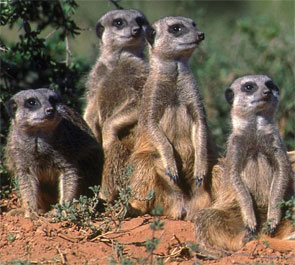Meerkats are teachers
Meerkats are teachers
mongabay.com
July 13, 2006
A team of scientists from Cambridge University has found that adult meerkats directly teach their young how to obtain food. The findings which are significant because they depart from the more commonly observed behavior whereby young learn simply by observing older members of their group. Evidence of true “teaching” with the sole intent of instructing young has been rare in animal research.
“Although there are anecdotal reports of teaching in species from chimpanzees to killer whales, until this year solid evidence was really lacking,” Alex Thornton, co-author of the study appearing in the July 14th issue of the journal Science and part of the Kalahari Meerkat Project in South Africa, told the Associated Press.
The meerkat is a small mammal that is a member of the mongoose family and inhabits the Kalahari Desert in southern Africa. They are social animals that live in colonies of up to forty individuals. The build extensive underground burrows with multiple entrances.
A press release from Cambridge University appears below.
Wild meerkats school their young
Cambridge University
University of Cambridge scientists have discovered that older meerkats teach pups how to obtain food by incrementally introducing dead, injured and then live prey. Although learning per se wouldn’t be surprising, whether wild mammals teach their young was still debated. The findings were published in this week’s edition of the journal Science.
Meerkats live in groups of three to 40 individuals in the arid regions of southern Africa. Each group includes a dominant male and female who produce over 80% of the pups. However, helpers (meerkats older than 90 days) and parents of both sexes aid in rearing the young.
Pups (meerkats younger than 90 days of age) are initially incapable of finding their own prey and therefore rely on provisions from other members of the group by responding to their begging calls for food. Meerkats typically feed on a range of unwieldy and often dangerous prey (including scorpions).
The Cambridge researchers discovered that in order for the helpers to teach the pups how to handle food without putting them in harm’s way, the older meerkats would kill or disable the prey before providing it to the pups. In the case of the scorpions, they often removed the sting. The helpers would then modify the frequency with which they killed or disabled the prey according to the pups’ age, recognised by their call, gradually introducing pups to live prey as they became older.
 Photo by R. Butler |
Alex Thornton, Department of Zoology, University of Cambridge, stated, “A greater understanding of the evolution of teaching is essential if we are to further our knowledge of human cultural evolution and for us to examine the relations between culture in our own species and cultural behaviour in other animals.”
Like any good teacher, the helpers would also monitor the pup after they had provided it with food. If the pup was reluctant to handle the prey, the older meerkat would nudge the item towards them to encourage it. Additionally, if the prey wondered off the helper would retrieve the item and return it to the pup, sometimes further disabling it before returning it to the young meerkat.
The researchers, Alex Thornton and Katherine McAuliffe, Department of Zoology, University of Cambridge, are part of the Kalahari Meerkat Project, located at the Kuruman River Reserve, South Africa. The project is a decade-old initiative by Professor Tim Clutton-Brock FRS in collaboration with the University of Pretoria. A study earlier this year by Dr Andrew Young and Professor Clutton-Brock reported that dominant female meerkats kill and eat their rival’s young.














